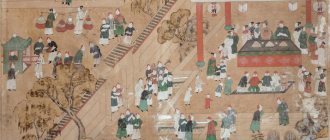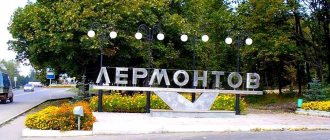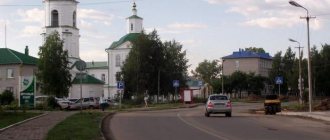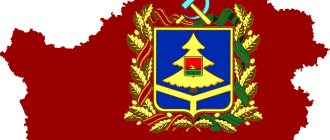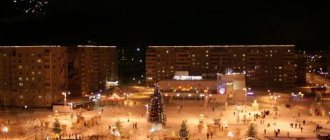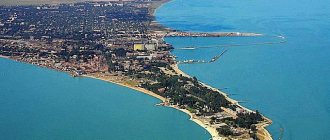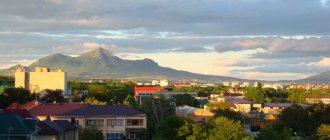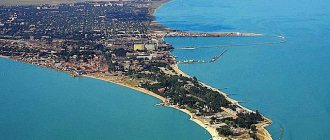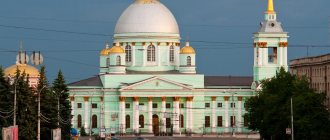People do not come to the city of Bodaibo for tourism purposes. There are no attractions here in the usual sense of the word, and getting here is quite expensive and difficult. If you are looking for where to go in Bodaibo, then you can guess that work has brought you to the Siberian outback. I myself was born “on the mainland”, for several years I came on business trips to this taiga region, and then I got married and became a local resident.
There is only one dirt road leading into the city, which is often washed out by rain.
Bodaibo is called the golden capital of Siberia for good reason. Almost the entire city is filled with artels and gold mining companies. Therefore, there are always a lot of “business travelers”, and they are all looking for something to do in Bodaibo.
Geography
The city is located in the right-bank floodplain valley of the Vitim River, at the confluence of the Bodaibo River, at an altitude of 280 m above sea level. It is surrounded by mountains formed by the spurs of the Kropotkinsky ridge (from the north) and the North Baikal Highlands (from the south).
The surrounding area is a mountain taiga area. In the right-bank floodplain part of Vitim, below the Bodaibo River, there are small areas of agricultural land that have been used since the 19th century. for haymaking, grazing and growing vegetables1.
Bodaibo is a land of gold and bones.
We say “Bodaybo”, we mean “gold”. In Bodaibo, you can talk with the local population on any topic - it will still very soon come up with the topic of Bodaibo gold. Here, each of the numerous artels is a city-forming enterprise. Because besides gold mining there is simply nothing to do in Bodaibo, excluding, of course, the “female” craft of the social sphere - shops, schools, district administration...
And the paradox is that far from being the largest district of the Irkutsk region, which annually replenishes the gold fund of the Russian Federation by 15-16 tons (just imagine this visually!) not only does not prosper and does not prosper - the district barely makes ends meet with ends. The Bodaibinsky district today, like a hundred years ago, is a hungry, exhausted prospector with an old handicraft tray, who walks around in rags for gold and mines precious sand “for his uncle”...
History of the Irkutsk Klondike.
Bodaibo from the height of an airplane flight resembles... Erbogachen. Both are regional centers. Erbogachen stretches out on the right bank of the Tunguska, Bodaibo along the Vitim. When the plane lands in Erbogachen, it feels like it is landing on potato beds. When the plane lands in Bodaibo, it lands right above the city, so it feels like it’s landing right on the roofs of buildings. But as soon as the plane stops, the main similarities and differences become visible. Erbogachen stands on sand - the entire village is on ordinary river sand. Bodaibo stands on golden sand. Residents joke: “We are walking on gold.”
The main paradox is that most Bodaibo residents have never seen gold. There is no jewelry made from local gold here, and the only jewelry store has imported gold. Although some say that if the state allowed the free circulation of gold, more than tens of kilograms of the precious metal would appear from the bins of some old residents of Bodaibo.
However, prosperity is obvious - with the ease of tricycles, a huge number of jeeps the size of a five-walled hut drive around Bodaibo. Of course, there are Nivas and some foreign cars there, but after living in Bodaibo for a week, we realized that the vast majority of cars are jeeps and UAZ tablets.
The second thing that catches your eye is that there is no cellular service in Bodaibo. And it is striking because so many local residents roam the streets and drive in cars with handsets from radiotelephones. It looks very funny after having your own miniature mobile phone.
Another fundamental difference between the Bodaibinsky district and others is that there are no villages or towns here. There is a mine here (with emphasis on the “a”). Once upon a time, prospectors dispersed along the banks of rivers in the vicinity of Bodaibo, settled, and panned for gold. As they say, we tried. Then gold mining moved further along the river beds, the settlements remained - and so they remained mines. So don’t think that a mine is where gold is washed.
And it all started out rather ridiculously. At the beginning of the 17th century, the Yakuts and Evenks lived in a deserted bend of the Lena River. And one day (no one remembers the year of this event) in Zhigalovo, in the Verkholensk region, a hunter from small nations came out with a nugget in his hand. He came to the fair to exchange skins for salt, and he held a nugget in his hand. There were literate people at the fair, they begged for a nugget, scratched their turnips - and in 1632, the development of the territory of the modern Bodaibo region began from the north.
In 1863, a detachment of Novitsky, one of Sibiryakov’s atamans, found gold on the Bodaibo River and founded a mining village - they measured out 21 plots. Then a city arose on the site of these sites.
By the way, there are two versions about the etymology of the word “Bodaibo”. One by one, having placed an “allotment” (that is, having allotted and registered the site), the prospector carefully prayed for gold (“give it, God”). This, distorted to "Bodaibo", became the name of the city of prospectors. According to another - traditional - version, this is an Evenki word, it means “this place”.
Modern history - perestroika killed the region.
“We didn’t have enough for two years,” as the refrain is repeated in Bodaibo and at the mines. Previously, under Soviet rule, Bodaibo, if not ruled, was at least not poor. Lenzoloto was a state organization, a real city-forming enterprise. Therefore, the social development plan was drawn up by gold miners together with the district administration, there was a single budget.
The area developed rapidly. Lenzoloto mines contained fur farms, poultry farms and state farms. The miners always had their own milk, meat, and eggs. They founded the city of Vachinsk - on the site of the same Vachinsky mine, about which Vysotsky sang “I’m going to Vacha - I’m crying, I’m going to Vacha - I’m laughing.” We built a KPD (large-panel house-building plant), a Finnish line of computerized equipment (built by the Finns, they also debugged the equipment and taught the locals how to work). We built the frame of the school, the supports of the bridge across the Vitim, to the village of Bisyaga, and the Mamakan hydroelectric power station. We created a project for the construction of an airport for heavy aircraft. We found a river alignment for the construction of the Telmamskaya hydroelectric power station.
Ray Bradbury has a science fiction story called “A Sound of Thunder.” A very real perestroika has broken out in Bodaibo. Lenzoloto became a joint-stock company. The artels separated and became closed joint stock companies - they wash gold and hand it over to Lenzoloto, but formally they are independent legal entities. Others decided to be on their own. A group of gold miners takes out a license, a bank loan for equipment, washes gold for a season, hands it over to the bank, and returns the loan. All that's left is all yours. And everyone turned out to be for themselves, and ordinary residents were out of business.
The fact is that both the CJSC and the cooperatives themselves would earn a profit. Maintaining farms and state farms is a noble, but unprofitable endeavor. Everything was closed at once. People were left without work, and in the early 90s the area became gold mining in the truest sense of the word - there was nothing left but gold mining. Of course, all mines are happy to provide any sponsorship upon request, but this is like giving a chocolate bar to someone dying of hunger.
What remains of the bridge are two pillars, access roads on the shore and a ferry that today transports from shore to shore. The frame of the school stares through the empty eye sockets of unglazed windows at the unfinished bridge. KPD was closed as unnecessary, because large-panel blocks were needed to build Vachinsk, and the construction was simply abandoned. Vachinsk became a ghost town. And they simply forgot about the airport for heavy aircraft. And the hydroelectric power station...
Electricity on permafrost.
In the middle of the taiga, where the Mamakan River flows into Vitim, there is an eternal rainbow - from a height of fifty meters, the water merges from the body of the Mamakan hydroelectric station and foams in a huge snow-white hump tens of meters up and into the distance. An artificial waterfall drains one and a half hundred cubic meters of water per second. This miracle of nature is the world's first hydroelectric power station on permafrost. It was built in an area with a sharply continental climate, where the snow already lies firmly in mid-October, and melts only in May, where average annual temperature fluctuations sometimes exceed seventy degrees - from minus forty in January to plus thirty in July.
On October 20, 1956, by decision of the Council of Ministers of the USSR No. 6353-r, a new Komsomol construction project was announced. On Mamakan, one thousand two hundred meters from the mouth where it flowed into the Vitim, Komsomol volunteers dug into the permafrost with picks and shovels, blocking the mountain river. And after five years of inhuman labor, on December 22, 1961 at 19.49 local time, the first unit of the hydroelectric power station was put under load, and another year later the last - the fourth - unit started working.
Ten years later (almost to the day - in September 1966) an act of the state commission was signed on the acceptance into operation of the completed construction of the Mamakan hydroelectric power station. Today, four hydroelectric power station generators, tirelessly grinding water with blades, produce up to one hundred megawatts with a maximum water flow of 356,000,000 kilowatts per hour.
The Mamakan hydroelectric power station was originally built for the needs of the gold mining industry - before that, each team struggled with its own diesel generator. Now, in addition to the miners, it provides electricity to both the Mamsko-Chuysky district and the Taksimo region - the neighboring Republic of Buryatia.
In the mid-80s, geological surveys were carried out and a place was found for another hydroelectric power station - Telmamskaya. They decided to place it several tens of kilometers upstream, where the Telmama River flows into Mamakan. The Telmamskaya hydroelectric power station would be three times more powerful than the Mamakanskaya hydroelectric station. Moreover, it was supposed to increase the water flow, increasing the guaranteed capacity of the Mamakan hydroelectric station from seven and a half to forty-six megawatts.
Core samples have already been taken at the construction site and the first stone has almost been laid. Like the entire region (let’s not talk about the fate of Russia in general), the Telmamskaya hydroelectric power station was killed by perestroika. Funding was stopped, the project was closed - according to Soviet money, the hydroelectric power station cost the state 320 million rubles. And instead of increasing the guaranteed power through the construction of the Telmamskaya hydroelectric power station, now only one generator out of four works on Mamakan in winter - the water flow is weak.
The settlement of power engineers is dying today. The descendants of Komsomol volunteers live out their days in oblivion, young people flee to Bodaibo and as far as possible. Today there are 2,000 people in the village, of which exactly a tenth—two hundred people—work at the hydroelectric power station. There is nothing else to do in the village. And the hydroelectric power station, operating at the limit of strength, today represents a raw material appendage for gold miners.
Golden rivers are rivers of clay soup.
Gold evokes strong emotions in everyone in the area, but not always positive ones. Director of Bodaibinsky Zveropromkhoz CJSC Nikolai Nikishov speaks of gold mining with persistent hostility: “They killed the land, Herods!”
-Give only gold to the state, but no one thinks about nature. Gold mining ruins rivers; after dredging, the water resembles a viscous clay broth of a dirty yellow color. The Bolshoi Paton River is polluted - the Yakuts no longer fish, laments Nikolai Stepanovich. - They say that they become drunkards. What remains for them? These are good people. If you don't deceive them, they also behave honestly.
By law, prospectors must compensate for damage caused to hunting grounds. Last year they paid about five hundred thousand rubles in fines. This year, two licenses for gold mining in hunting areas were canceled. But all this is a thorn in the side of the mammoth. The state needs gold, and environmental problems are local problems.
The animal farm is one of the oldest enterprises in the Bodaibinsky district. Previously, under the communists, there were 115 full-time hunters, most of them Evenks and Yakuts. Previously, eighteen tons of fish and meat were harvested per year. Now there are no full-time hunters - people are left without experience, without pensions, without social guarantees. The Tungus and Yakuts on Bolshoi Paton receive nine licenses for free, as well as weapons for the hunting season. They have free electricity, northern deliveries are underway. But small nations are offended by the state.
The main income of hunters today is sable hunting. At least two thousand skins are mined in the region per season, and the skin costs at least a thousand rubles. A license for one sable costs 120 rubles.
A good hunter can earn from eighty to one hundred thousand in a season, but people are reluctant to go into the taiga - why, when they can make money on gold. Due to the fact that the region is industrial, ancestral lands are not even identified in the area. Small nationalities traditionally hunt on Bolshoy Paton; Russians traditionally do not bother with them.
“There are more than two thousand hunters in my area, but at most four hundred people will go to the taiga this year,” Nikolai Stepanovich sadly shakes his head. “There are not enough people: the old are dying, the young are leaving, abandoning their land. But we have the best sable - Barguzin. That year they came from Kolyma and asked to sell them sables for breeding. We sold twenty sables for 12,000 rubles!
Recently, very little meat has been produced, about four tons per year. Last year, 62 reindeer, six red deer and six elk were harvested. And what to do with them - public catering has collapsed, there is nowhere to donate meat, and it is not profitable to take it out of the area yourself. But you can’t sell it in the area for a very funny reason. It is not profitable to sell a kilogram of wild meat (venison, elk, red deer) for less than eighty rubles. And in Bodaibo, all imported meat is half the price: it is believed that this is a golden, rich region, so products are brought here from everywhere: from Altai, Yakutia, Buryatia, Novosibirsk - and further to the west, from all major cities, including Moscow. As a result, the market is oversaturated, people are not very rich - you won’t be able to get them back. And prices fall like shell-shocked people.
The highest point of Bodaibo. The gold of the future is ore gold.
Since the time when the prospector washed gold with a tray knee-deep in the river, the technology has not fundamentally changed - despite the technology, industrial scale, the principle of mining has remained the same as a hundred years ago. The most common are dredge and mine. The most popular is mining by dredge, a huge machine that looks like a dragon and makes corresponding sounds: the dredge howls, groans, roars in an absolutely alive voice. In essence, this monster with a long neck and tail is a conveyor belt, which at one end swallows gold-bearing ore along the banks and bottom of the Bodaibo rivers, and throws out waste rock, beating gold sand on its endless conveyor belt.
The method, by the way, is the most environmentally criminal. Thanks to the dredges, the surroundings of the mines resemble some kind of lunar landscapes - these are mountains of rubble up to the very horizon, among which a road snakes, thickly beaten with meteorite craters. However, the era of alluvial and native gold is ending. Today in the Bodaibo region they are mastering the technology of mining and processing plants (mining and processing plants) - the same notorious Sukhoi Log, for example. Unlike dredges, which extract gold from the surface of the earth, mining and processing plants mine ore gold, which is located in rock ore.
The first gold mining and processing plant, Vysochaishy, was launched at the beginning of this year. It stands at an altitude of 1070 meters above sea level. Now he mines a ton of gold a year, but plans to mine three - the license was issued for 12 years. Currently, the mining and processing plant employs 226 people. The salary of a simple worker is $300-700 depending on qualifications. The principle of operation is the extraction of gold “on contact” using the gravitational method.
Simply put, the mountain (more precisely, the char), on the top of which “Vysochaishy” stands, contains gold - about two and a half grams per ton of soil. Gold is “in contact,” that is, the grain is contained in accompanying minerals, one of which is pyrite. The gravity method means that gold is mined by gravity. The rock is crushed by excavators, taken to the mining and processing plant, poured into a bunker and crushed. First, in cascades - huge drums rotating around their axis, in which many heavy metal balls roll, which crush the ore. Then, in a Nelson centrifuge, finer gold is extracted. Then they wash it several times, finally extracting the precious grains.
According to Deputy Director for Production Igor Sosipatorov, 85% of the gold contained in the ore is mined “by gravity”. This is more than in dredge or shaft mining. They don’t yet know how to extract 100% gold, so in Bodaibo they call the dumps of processed crushed stone “golden mountains.”
People are tired of gold.
If there is some kind of occupational disease among miners, if there is some kind of Bodaibo syndrome, it is well known to doctors and is described in detail in the specialized literature. This is chronic fatigue syndrome - they say that it is a very fashionable disease among workaholics now.
But if in clerks and top managers it manifests itself in hysterics, stress and depression, and the worst thing that can happen is divorce, then for gold miners it is often a fatal disease.
The work of miners is a shift method taken to the point of absurdity, 12 x 12. That is, you work twelve hours, sleep the same amount - and so on, without days off or holidays, for the entire season, from the end of March to the end of October. In water, dampness, dirt, drafts, with minimal safety precautions, six thousand miners work twelve hours a day.
The chief physician of the Bodaibo Central District Hospital, Igor Nikulin, said that in August-September, miners experience an avalanche-like exacerbation of all existing chronic diseases, the number of heart attacks and strokes becomes critical, and injuries sharply increase: miners strive to fall from something higher, they are crushed by heavier loads, and the most severe accidents occur . And as a logical conclusion - a high percentage of industrial mortality. In Bodaibo we were told how people die behind the levers of an excavator.
-Often health problems are caused by a common geographical factor. That is, people come from the flatlands to our midlands. People come to us from Ukraine, the Middle Volga region, and neighboring countries. After 25 years, it is categorically not recommended for people to change the climate; the body is no longer able to adapt. A sharp drop in pressure results in strokes and heart attacks,” said Igor Vyacheslavovich.
Every year in the spring, several “snowdrops” melt from under the snow - in Bodaibo these are not just winter criminal corpses, but prospectors killed after the season, having received a settlement in their hands. There is one near Bodaibo on one of the roads called Pykhti-Gora. The road from the mines passes through it. On one side it seems to have been cut off with a knife, and Vitim is splashing under the cliff. Miners are killed on the road regularly, 3-4 people a year. And they find out about this after the bandits try to... hide the corpses. The place seems convenient - I threw it off the cliff in Vitim, look for it and find it. But few people know that at the foot of Pykhti Mountain, on the Vitim side, there is a shelf on which bodies fall before reaching the water.
The other side of this coin is the homeless. In Bodaibo, all the homeless people are not just anyone, but failed prospectors. A typical story: a man flew in for a long gold ruble, hired himself to work at a mine, in anticipation of a sky full of diamonds and pockets full of nuggets, went on a drinking binge, and such people are immediately kicked out of the mines. There is no money for the return trip, everything is drunk - welcome to the brotherhood of the Bodaibo homeless people! In the summer they live in communes in abandoned houses in Bodaibo, and in the winter they come to the hospital for treatment and food.
Oddly enough, Bodaibo is not deprived of some of the excesses inherent in megacities - drug addicts and HIV-infected people. True, these two groups are mutually intertwined here: the overwhelming number of HIV-infected people are local drug addicts. Now in Bodaibo there are 49 identified HIV-infected people and 37 registered drug addicts (there were 69, but some died, some left).
Transporting drugs by plane from Irkutsk is unprofitable and simply dangerous, so it comes from Buryatia - by ferry from Taksimo. When there is a delay in the supply of heroin (this happens two or three times a year), local drug addicts in chaotic rows go to the hospital - to smoke, go through withdrawal, cleanse the blood and wait for the next ferry from Taximo. Once, a couple of years ago, I had no heroin for a very long time. Local bandits said, “It’s us,” and announced the “Brothers Against Drugs” campaign. And then it turned out that there was an ordinary supply disruption.
Transport accessibility
The distance from Bodaibo to the regional center in a straight line is 885 km, along the road (via Taksimo-Severobaykalsk-Zhigalovo) - 1444 km. There is Bodaibo Airport.
Distance from Bodaibo to some cities, km
| City | Distance by road |
| Severobaykalsk | 634 |
| Ust-Kut | 970 |
| Kirensk | 1040 |
| Bratsk | 1339 |
| Irkutsk | 1444 |
| Shelekhov | 1462 |
| Angarsk | 1488 |
| Usolye-Sibirskoye | 1519 |
| Slyudyanka | 1556 |
| Tulun | 1564 |
| Cheremkhovo | 1592 |
| Baykalsk | 1595 |
| Ust-Ilimsk | 1599 |
| Nizhneudinsk | 1687 |
| Taishet | 1844 |
| Ulan-Ude | 1894 |
| Krasnoyarsk | 2213 |
City coat of arms
The city of Bodaibo has its own coat of arms. And quite interesting. It was developed in 2004 according to sketches by Oksana Fefelova.
The red field of the shield depicts a lynx lying on a large chest. Both figures are gold, which is not at all surprising. The chest symbolizes wealth and its increase. But the lynx hints that these riches still need to be obtained, which is not so easy. In addition, this animal is quite common in the forests surrounding the city on all sides.
Population
Population dynamics
| 1931 | 1939 | 1959 | 1970 | 1979 | 1989 | 1992 | 1996 | 1998 |
| 3500 | 15 100 | 18 226 | 13 898 | 14 411 | 20 939 | 21 700 | 19 800 | 18 700 |
| 2000 | 2001 | 2002 | 2003 | 2005 | 2006 | 2007 | 2008 | 2009 |
| 17 700 | 17 500 | 16 504 | 16 500 | 16 000 | 15 700 | 15 500 | 15 200 | 14 821 |
| 2010 | 2011 | 2012 | 2013 | 2014 | 2015 | 2016 | 2017 | 2018 |
| 15 340 | 15 286 | 14 859 | 14 408 | 14 176 | 13 896 | 13 419 | 13 104 | 12 316 |
| 2019 | 2020 | |||||||
| 11 931 | 11 982 |
Story
Bodaibo was founded in 1864 as the Bodaibo mine residence (cargo warehouse), serving the Stefano-Afanasyevsky mine, when a year earlier the search party of the Irkutsk merchant Mikhail Sibiryakov discovered a gold-bearing placer in the Bodaibo River basin. On June 10 (June 23), 1903, in St. Petersburg, at the request of residents of the Bodaibo residence, the last Russian Tsar Nicholas II signed a decree giving the village of Bodaibo residence the status of a city[2].
From 1894 to 1967, Bodaibo was the starting station of the narrow-gauge Bodaibo Railway.
In 1912, a mass execution of a strike at the mines took place in the Bodaibo area.
In 1925, the village received city status.
In 2007, with major deficiencies, a dirt road to the nearest Taksimo railway station on BAM was put into operation. To this day, the road ends with an unfinished bridge over the Vitim River. Therefore, road communication with the city is seasonal (in summer there is a ferry crossing, in winter there is an ice crossing).
Economy
The main economic sector of the city of Bodaibo and the region is gold mining. The annual contribution of the region to the total gold production of the Russian Federation is about 9.3%, of which the share in production from alluvial deposits reaches 18.3%.
The volume of gold production by enterprises in the Bodaibinsky district in 2022 amounted to about 24.8 tons, including about 11 tons of alluvial gold.
33 large and small enterprises in the region are engaged in the extraction of placer gold.
The largest volume of alluvial gold production in 2022 will be achieved by JSC ZDK Lenzoloto (with its subsidiaries JSC Svetly, JSC Marakan, JSC Lensib, JSC Sevzoto, JSC Dalnyaya Taiga).
Gold ore mining in the Bodaibinsky district is carried out by JSC Polyus Verninskoye, PJSC Vysochaishy, LLC Druza, LLC GRK Ugakhan2.
Other enterprises: Mamakanskaya HPP, OJSC Vitimzhilstroy, food industry enterprises.
Organizational aspects: how to get there, where to eat, what to get around on, where to live
Even just coming to Bodaibo can be a great adventure. The fastest and most convenient way is by plane. Propeller aircraft fly here from Irkutsk. But the Bodaibo runway is unpaved, so it is often washed away by rain.
Some people take the train to Taksimo and travel the remaining 800 kilometers by taxi. Roads (also dirt roads) are often washed away, so getting stuck in Bodaibo for a few extra days, or even weeks, is a common story. Due to such logistical problems, the city has a huge problem with food. Many stores do not hesitate to sell expired goods, so you need to carefully study the labels before purchasing. Although local businessmen have learned to fake dates on packages. There are several cafes in the city, the quality of food in which also directly depends on the season. In the fall, during prolonged rains, food is not delivered to the city for weeks. Accordingly, the menu in public establishments is sharply reduced.
The whole town fits into one photo.
As for getting around Bodaibo, I can only recommend a taxi. But the town itself is so small that getting around it on foot is not difficult. Of course, in winter, when the temperature reaches −45°, walking down the street for more than 15 minutes is not very pleasant. But the rest of the time, public transport is unlikely to be useful to you.
There are 2 small hotels in the city: “Taiga” and “Noy”. Places in Taiga are reserved by local gold mining companies for their guests. Noah is easier to get to, but be prepared for the fact that there is a bar and billiards on the ground floor. Accordingly, noise is ensured in the evenings. If you need to look for housing on your own, then the only way out is daily apartments. Advertisements can be found on Avito.
Climate
Bodaibo has a sharply continental climate with long frosty winters and short hot summers. In summer, temperatures in Bodaibo can reach almost 40 °C, which is unique for such a high latitude.
The city of Bodaibo is equated to the regions of the Far North.
| Bodaibo Climate | |||||||||||||
| Index | Jan. | Feb. | March | Apr. | May | June | July | Aug. | Sep. | Oct. | Nov. | Dec. | Year |
| Absolute maximum | 3,3 | 4,5 | 11,8 | 21,2 | 32,7 | 39,6 | 38,6 | 36,6 | 28,7 | 19,1 | 10,3 | 4,2 | 39,6 |
| Average maximum, °C | −26 | −20,9 | −7 | 4,3 | 13,4 | 22,8 | 25,8 | 22,2 | 13,2 | 0,9 | −14,1 | −24,2 | 1,2 |
| Average temperature, °C | −29,9 | −26,6 | −15,1 | −2,5 | 6,4 | 14,5 | 17,9 | 14,7 | 6,8 | −3,2 | −18,3 | −27,7 | −5,1 |
| Average minimum, °C | −34,6 | −32,2 | −22,6 | −8,6 | −0,1 | 7,2 | 11,4 | 9,3 | 2,7 | −6,5 | −22,5 | −32,1 | −10,7 |
| Absolute minimum, °C | −55,1 | −51,4 | −46,7 | −33,7 | −14,3 | −3,7 | 0,5 | −1,8 | −8,9 | −32,9 | −45,3 | −52,1 | −55,1 |
| Precipitation rate | 21,7 | 12,6 | 9,4 | 15,9 | 36,5 | 67,5 | 84,3 | 80,2 | 54,6 | 28,5 | 28,2 | 25 | 464,4 |
| Source: [thermo.karelia.ru/weather/w_precips_ru_bod.shtml Thermo Karelia.Ru] [www.worldclimate.com/cgi-bin/grid.pl?gr=N57E114 World Climate] | |||||||||||||
Notes
- ↑ 12
www.gks.ru/free_doc/doc_2016/bul_dr/mun_obr2016.rar Population of the Russian Federation by municipalities as of January 1, 2016 - Bodaibo // Encyclopedic Dictionary of Brockhaus and Efron: in 86 volumes (82 volumes and 4 additional). - St. Petersburg, 1890-1907.
- ↑ 123456789101112
www.MojGorod.ru/irkutsk_obl/bodajbo/index.html People's encyclopedia “My City”. Bodaibo (city) - [demoscope.ru/weekly/ssp/rus59_reg2.php All-Union Population Census of 1959. The size of the urban population of the RSFSR, its territorial units, urban settlements and urban areas by gender] (Russian). Demoscope Weekly. Retrieved September 25, 2013. [www.webcitation.org/6GDOghWC9 Archived from the original on April 28, 2013].
- [demoscope.ru/weekly/ssp/rus70_reg2.php All-Union Population Census of 1970 The size of the urban population of the RSFSR, its territorial units, urban settlements and urban areas by gender.] (Russian). Demoscope Weekly. Retrieved September 25, 2013. [www.webcitation.org/6GDOiMstp Archived from the original on April 28, 2013].
- [demoscope.ru/weekly/ssp/rus79_reg2.php All-Union Population Census of 1979 The size of the urban population of the RSFSR, its territorial units, urban settlements and urban areas by gender.] (Russian). Demoscope Weekly. Retrieved September 25, 2013. [www.webcitation.org/6GDOjhZ5L Archived from the original on April 28, 2013].
- [demoscope.ru/weekly/ssp/rus89_reg2.php All-Union Population Census of 1989. Urban population]. [www.webcitation.org/617x0o0Pa Archived from the original on August 22, 2011].
- [www.perepis2002.ru/ct/doc/1_TOM_01_04.xls All-Russian Population Census 2002. Volume. 1, table 4. Population of Russia, federal districts, constituent entities of the Russian Federation, districts, urban settlements, rural settlements - regional centers and rural settlements with a population of 3 thousand or more]. [www.webcitation.org/65AdCU0q3 Archived from the original on February 3, 2012].
- [www.gks.ru/bgd/regl/B09_109/IssWWW.exe/Stg/d01/tabl-21-09.xls Number of permanent population of the Russian Federation by cities, urban-type settlements and districts as of January 1, 2009]. Retrieved January 2, 2014. [www.webcitation.org/6MJmu0z1u Archived from the original on January 2, 2014].
- [195.46.100.221/vpn2010/DocLib/totals-vpn2010-2.pdf Results of the 2010 All-Russian Population Census for the Irkutsk Region]. Retrieved September 23, 2013. [www.webcitation.org/6JqAskf9l Archived from the original on September 23, 2013].
- ↑ 12
[www.irkobl.ru/sites/economy/Anticorrup_ekspertiza/statistika.doc Population by municipalities as of January 1, 2012: stat. Bulletin / Irkutskstat. – Irkutsk, 2012. – 81 p.]. Retrieved September 24, 2016. [web.archive.org/web/20160306103555/irkobl.ru/sites/economy/anticorrup_ekspertiza/statistika.doc Archived from the original on September 24, 2016]. - [www.gks.ru/free_doc/doc_2013/bul_dr/mun_obr2013.rar Population of the Russian Federation by municipalities as of January 1, 2013. - M.: Federal State Statistics Service Rosstat, 2013. - 528 p. (Table 33. Population of urban districts, municipal districts, urban and rural settlements, urban settlements, rural settlements)]. Retrieved November 16, 2013. [www.webcitation.org/6LAdCWSxH Archived from the original on November 16, 2013].
- [www.gks.ru/free_doc/doc_2014/bul_dr/mun_obr2014.rar Table 33. Population of the Russian Federation by municipalities as of January 1, 2014]. Retrieved August 2, 2014. [www.webcitation.org/6RWqP50QK Archived from the original on August 2, 2014].
- [www.gks.ru/free_doc/doc_2015/bul_dr/mun_obr2015.rar Population of the Russian Federation by municipalities as of January 1, 2015]. Retrieved August 6, 2015. [www.webcitation.org/6aaNzOlFO Archived from the original on August 6, 2015].
- [teksty-pesen-rus.ru/VysotskijVladimir/ProRechku.htm “About the Vacha River and fellow traveler Valya”]
